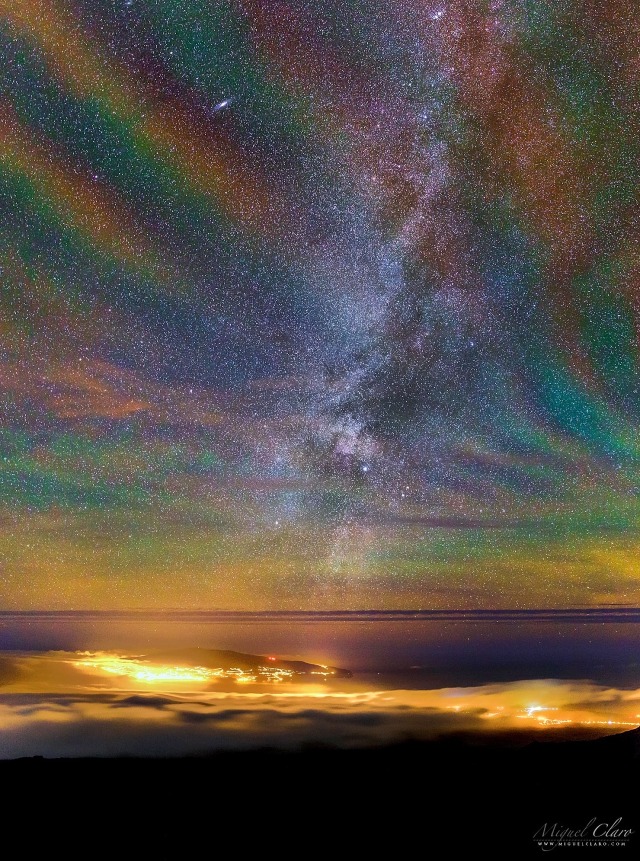#airglow

A rainbow airglow! Air glows all of the time, but it is usually hard to see. A disturbance, like a storm, may cause noticeable rippling in the Earth’s atmosphere. These gravity waves are oscillations in air, just like the ripples created when a rock is thrown in calm water. Makes sense right? But where do the colors come from? The deep red glow likely originates from OH molecules excited by ultraviolet light from the Sun. The orange and green airglow is likely caused by sodium and oxygen atoms slightly higher up. A spectacular sky is visible through this airglow, with the central band of our Milky Way Galaxy running up the image center, and M31, the Andromeda Galaxy, visible near the top left.
Image Credit & Copyright: Miguel Claro (TWAN); Rollover Annotation: Judy Schmidt

Airglow over the Atacama
One of the several rising steps that climbs to the main cordillera of the Andes through the driest desert on Earth resembles a beach abutting onto a sea of clouds below and provides the backdrop for this gorgeous photo of airglow above the southern skies with our galaxy in the sky above. The ripples are caused by atmospheric waves and produce a completely different pattern to those in the skies above the Tibetan Plateau I shared once before (see http://on.fb.me/1MC62j0).
It’s not just auroras that fill our sky with eerie light. The weaker phenomenon in the photo is called airglow (aka nightglow), and unlike the aurora, which is focussed towards the poles by Earth’s magnetic field, it can be seen from anywhere on Earth with luck and a dark sky or long exposure photo. Both phenomena arise from excited atmospheric atoms, but with different solar sources for the excitation energy. Like aurorae, airglow can be patchy and shift on a scale of minutes across the night sky. It is also present during the day but hidden in the glare.
Aurorae are due to high speed collisions with the high energy particles in the solar wind, usually during a coronal mass ejection that is pointed towards our planet and funnelled down our world’s field lines. Airglow arises from high energy components of ordinary sunlight, in this case short wave ultraviolet and X-Rays. Several mechanisms combine in the lower reaches of space to produce this glow.
Between 80 and 100 Km up from the surface, oxygen atoms get chemically excited and ionised (the electrons are stripped off from the nuclei by the energy). They then react with hydroxyl molecules (OH) to form water, or recombine into O2 and start to glow green from both chemically stimulated energy and the decay of those atoms excited by cosmic rays (just once in my life I think I’ve had the blue flash of Cherenkov radiation in one eye reported by astronauts). They only occur at high altitude because lower down the nitrogen in the atmosphere quenches the reaction. Other types of atom also recombine to contribute to the effect, such as nitrogen and oxygen forming nitric oxide (NO), emitting a photon of light as they do so.
It was first identified by the Swede Angstrom in 1868, and subsequent laboratory studies have shown the chemical pathways that create the light as an energetic by product of the photochemical reactions. It limits the sensitivity of ground based telescopes at visible wavelengths, and is one of the reasons space telescopes are so useful to astronomers, as they can see faint objects normally masked by airglow. It usually appears bluish green, and seems brightest about ten degrees above the horizon. Only part of the layer of air that forms our bubble glows, too high up and the atoms are too tenuous to combine, too low and their density means that the energy is dissipated by collisions rather than photochemical reactions.
While it is normally quite weak, and the photographer tells me that this picture has an unusual intensity for the phenomenon, he states that a friend obtained similar results when shooting from the same place in the same direction.
Sometime in the next couple of days, we’ll put up a photo of airglow from space, so you can see the shimmering band that encircles our wonderful Blue Marble.
Loz
Image credit: Yuri Beletsky (Carnegie Las Campanas Observatory) via APOD.
http://bit.ly/1JGwDta
http://bit.ly/1VByYuy
http://bit.ly/1JSJrcK
Milky Way and airglow reflection in Bodie at night. Three photographic exposures with minor Lightroom adjustments, stacked, nothing layered/copied/pasted/time-shifted/faked.
.
.
.
#nightphotography #milkyway #easternsierra #california #abandonedplaces #ghosttown #airglow (at Bodie State Historic Park)
https://www.instagram.com/p/CSmhGstlX1U/?utm_medium=tumblr
Post link


